Innovation and Future Development: A Case Study of made.com
VerifiedAdded on 2021/01/02
|6
|1423
|330
Report
AI Summary
This report provides an analysis of made.com's innovation strategies, focusing on the application of the Diffusion of Innovation (DOI) theory. The report begins by defining innovation and introduces made.com as a case study, a company providing furniture services. It then delves into the DOI theory, explaining its core concepts and the five adopter categories: innovators, early adopters, early majority, late majority, and laggards. The report applies the DOI theory to made.com's past innovations, such as NFC and Cloud Tags, and discusses the time and strategies needed for customer adoption. Furthermore, it explores made.com's future product development, including robotic furniture and high-tech wardrobes, highlighting how these innovations aim to enhance customer experience and expand market share. The conclusion emphasizes the role of innovation in gaining a competitive advantage and ensuring business sustainability, reiterating the applicability of the DOI theory for improving products and services.
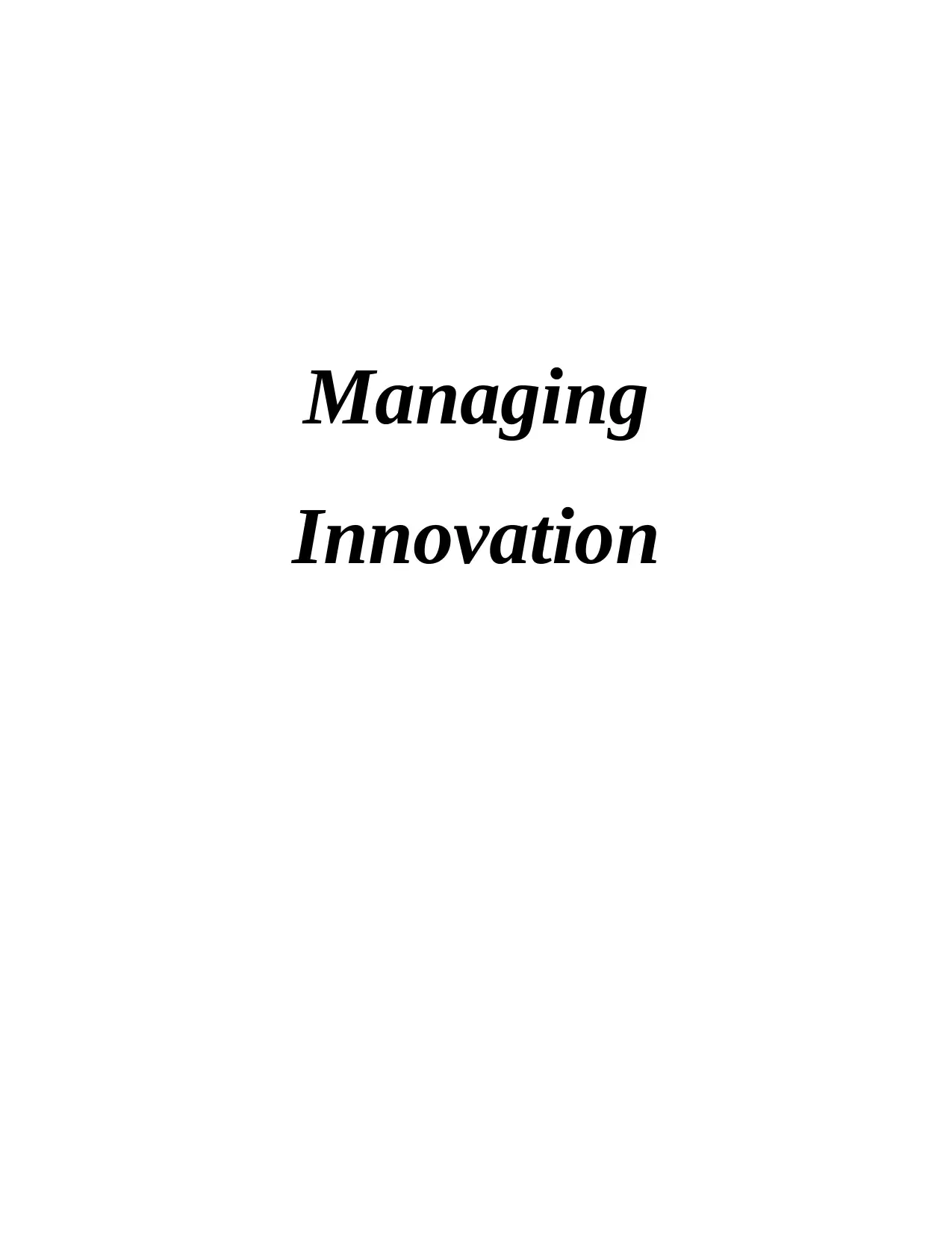
Managing
Innovation
Innovation
Paraphrase This Document
Need a fresh take? Get an instant paraphrase of this document with our AI Paraphraser
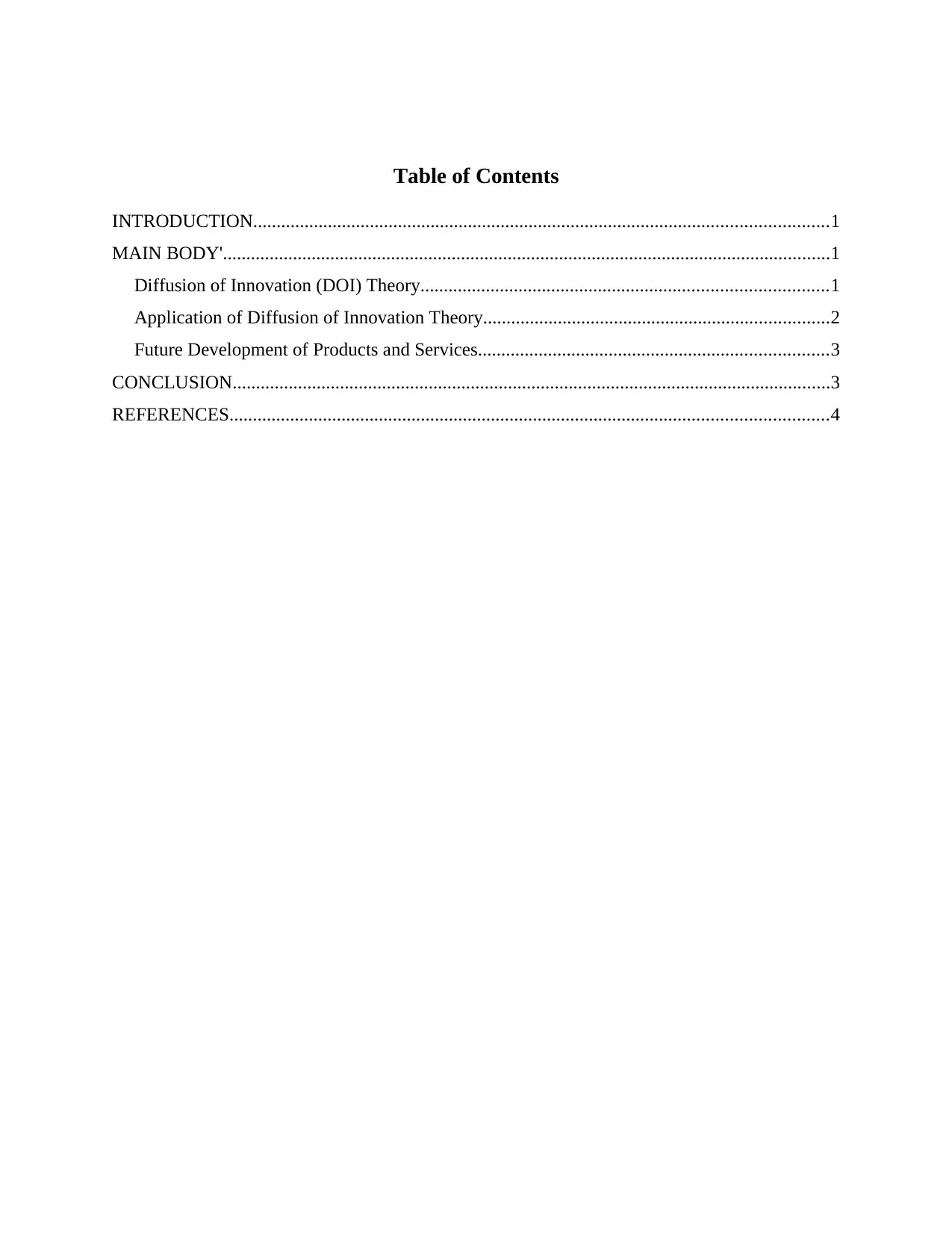
Table of Contents
INTRODUCTION...........................................................................................................................1
MAIN BODY'..................................................................................................................................1
Diffusion of Innovation (DOI) Theory.......................................................................................1
Application of Diffusion of Innovation Theory..........................................................................2
Future Development of Products and Services...........................................................................3
CONCLUSION................................................................................................................................3
REFERENCES................................................................................................................................4
INTRODUCTION...........................................................................................................................1
MAIN BODY'..................................................................................................................................1
Diffusion of Innovation (DOI) Theory.......................................................................................1
Application of Diffusion of Innovation Theory..........................................................................2
Future Development of Products and Services...........................................................................3
CONCLUSION................................................................................................................................3
REFERENCES................................................................................................................................4
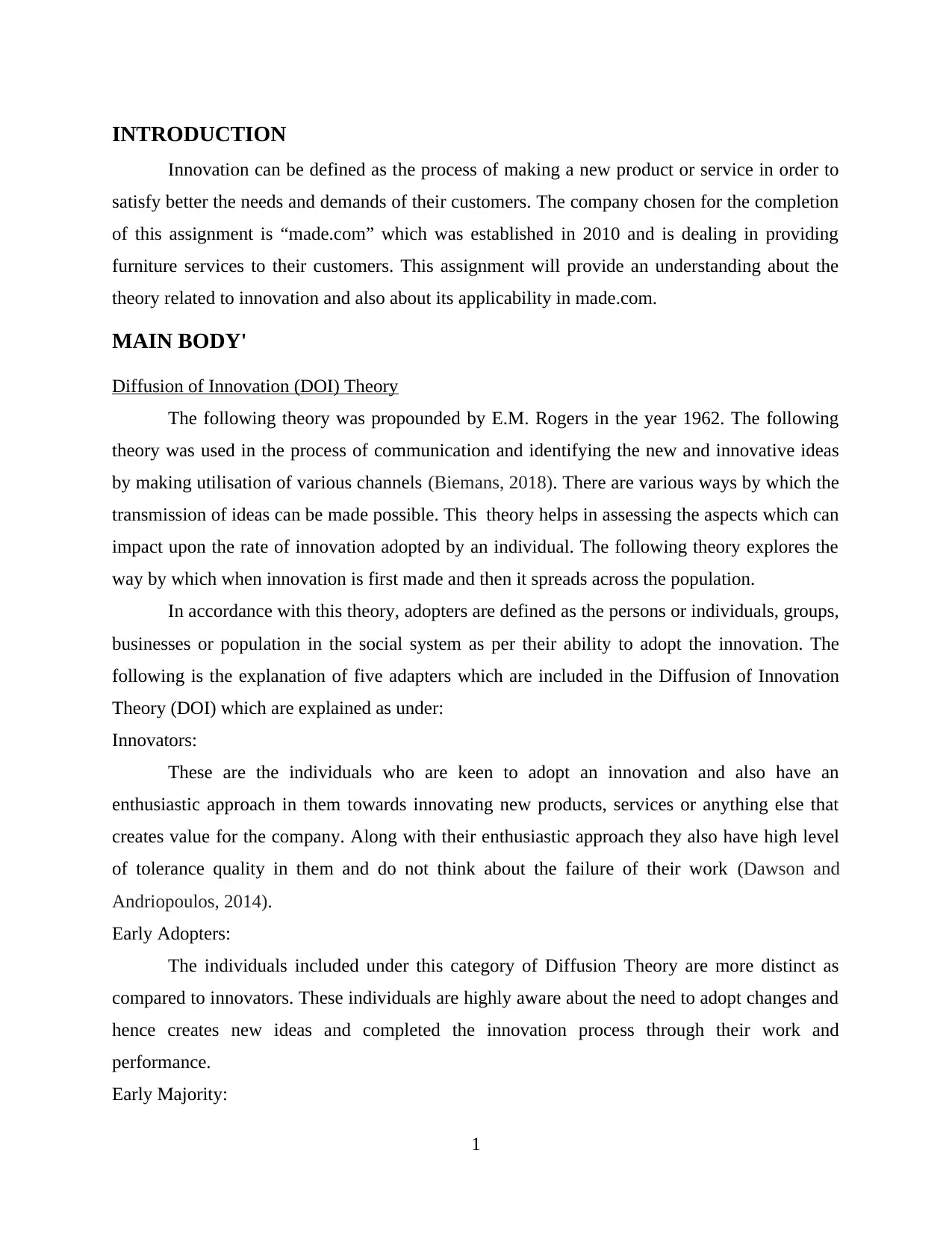
INTRODUCTION
Innovation can be defined as the process of making a new product or service in order to
satisfy better the needs and demands of their customers. The company chosen for the completion
of this assignment is “made.com” which was established in 2010 and is dealing in providing
furniture services to their customers. This assignment will provide an understanding about the
theory related to innovation and also about its applicability in made.com.
MAIN BODY'
Diffusion of Innovation (DOI) Theory
The following theory was propounded by E.M. Rogers in the year 1962. The following
theory was used in the process of communication and identifying the new and innovative ideas
by making utilisation of various channels (Biemans, 2018). There are various ways by which the
transmission of ideas can be made possible. This theory helps in assessing the aspects which can
impact upon the rate of innovation adopted by an individual. The following theory explores the
way by which when innovation is first made and then it spreads across the population.
In accordance with this theory, adopters are defined as the persons or individuals, groups,
businesses or population in the social system as per their ability to adopt the innovation. The
following is the explanation of five adapters which are included in the Diffusion of Innovation
Theory (DOI) which are explained as under:
Innovators:
These are the individuals who are keen to adopt an innovation and also have an
enthusiastic approach in them towards innovating new products, services or anything else that
creates value for the company. Along with their enthusiastic approach they also have high level
of tolerance quality in them and do not think about the failure of their work (Dawson and
Andriopoulos, 2014).
Early Adopters:
The individuals included under this category of Diffusion Theory are more distinct as
compared to innovators. These individuals are highly aware about the need to adopt changes and
hence creates new ideas and completed the innovation process through their work and
performance.
Early Majority:
1
Innovation can be defined as the process of making a new product or service in order to
satisfy better the needs and demands of their customers. The company chosen for the completion
of this assignment is “made.com” which was established in 2010 and is dealing in providing
furniture services to their customers. This assignment will provide an understanding about the
theory related to innovation and also about its applicability in made.com.
MAIN BODY'
Diffusion of Innovation (DOI) Theory
The following theory was propounded by E.M. Rogers in the year 1962. The following
theory was used in the process of communication and identifying the new and innovative ideas
by making utilisation of various channels (Biemans, 2018). There are various ways by which the
transmission of ideas can be made possible. This theory helps in assessing the aspects which can
impact upon the rate of innovation adopted by an individual. The following theory explores the
way by which when innovation is first made and then it spreads across the population.
In accordance with this theory, adopters are defined as the persons or individuals, groups,
businesses or population in the social system as per their ability to adopt the innovation. The
following is the explanation of five adapters which are included in the Diffusion of Innovation
Theory (DOI) which are explained as under:
Innovators:
These are the individuals who are keen to adopt an innovation and also have an
enthusiastic approach in them towards innovating new products, services or anything else that
creates value for the company. Along with their enthusiastic approach they also have high level
of tolerance quality in them and do not think about the failure of their work (Dawson and
Andriopoulos, 2014).
Early Adopters:
The individuals included under this category of Diffusion Theory are more distinct as
compared to innovators. These individuals are highly aware about the need to adopt changes and
hence creates new ideas and completed the innovation process through their work and
performance.
Early Majority:
1
⊘ This is a preview!⊘
Do you want full access?
Subscribe today to unlock all pages.

Trusted by 1+ million students worldwide
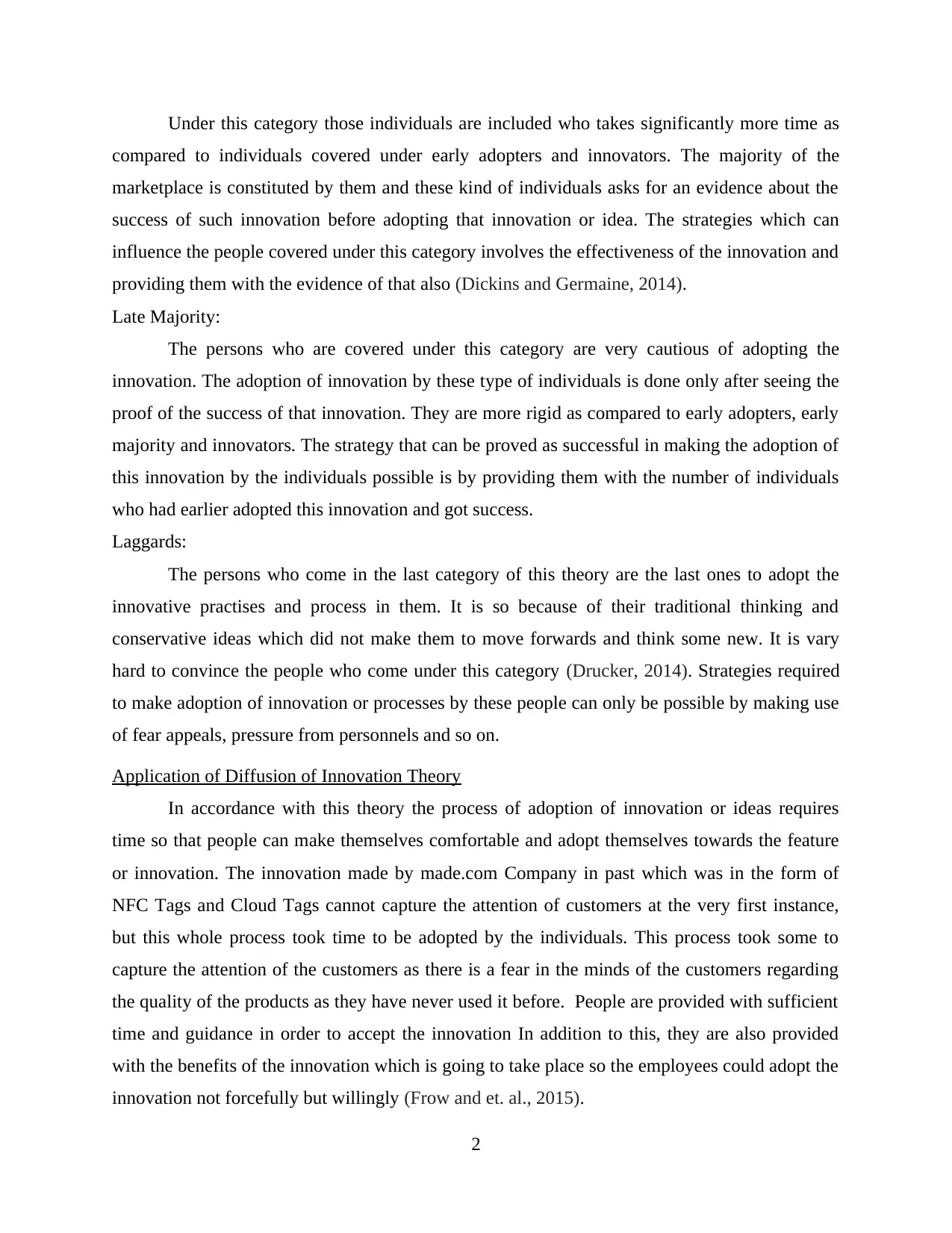
Under this category those individuals are included who takes significantly more time as
compared to individuals covered under early adopters and innovators. The majority of the
marketplace is constituted by them and these kind of individuals asks for an evidence about the
success of such innovation before adopting that innovation or idea. The strategies which can
influence the people covered under this category involves the effectiveness of the innovation and
providing them with the evidence of that also (Dickins and Germaine, 2014).
Late Majority:
The persons who are covered under this category are very cautious of adopting the
innovation. The adoption of innovation by these type of individuals is done only after seeing the
proof of the success of that innovation. They are more rigid as compared to early adopters, early
majority and innovators. The strategy that can be proved as successful in making the adoption of
this innovation by the individuals possible is by providing them with the number of individuals
who had earlier adopted this innovation and got success.
Laggards:
The persons who come in the last category of this theory are the last ones to adopt the
innovative practises and process in them. It is so because of their traditional thinking and
conservative ideas which did not make them to move forwards and think some new. It is vary
hard to convince the people who come under this category (Drucker, 2014). Strategies required
to make adoption of innovation or processes by these people can only be possible by making use
of fear appeals, pressure from personnels and so on.
Application of Diffusion of Innovation Theory
In accordance with this theory the process of adoption of innovation or ideas requires
time so that people can make themselves comfortable and adopt themselves towards the feature
or innovation. The innovation made by made.com Company in past which was in the form of
NFC Tags and Cloud Tags cannot capture the attention of customers at the very first instance,
but this whole process took time to be adopted by the individuals. This process took some to
capture the attention of the customers as there is a fear in the minds of the customers regarding
the quality of the products as they have never used it before. People are provided with sufficient
time and guidance in order to accept the innovation In addition to this, they are also provided
with the benefits of the innovation which is going to take place so the employees could adopt the
innovation not forcefully but willingly (Frow and et. al., 2015).
2
compared to individuals covered under early adopters and innovators. The majority of the
marketplace is constituted by them and these kind of individuals asks for an evidence about the
success of such innovation before adopting that innovation or idea. The strategies which can
influence the people covered under this category involves the effectiveness of the innovation and
providing them with the evidence of that also (Dickins and Germaine, 2014).
Late Majority:
The persons who are covered under this category are very cautious of adopting the
innovation. The adoption of innovation by these type of individuals is done only after seeing the
proof of the success of that innovation. They are more rigid as compared to early adopters, early
majority and innovators. The strategy that can be proved as successful in making the adoption of
this innovation by the individuals possible is by providing them with the number of individuals
who had earlier adopted this innovation and got success.
Laggards:
The persons who come in the last category of this theory are the last ones to adopt the
innovative practises and process in them. It is so because of their traditional thinking and
conservative ideas which did not make them to move forwards and think some new. It is vary
hard to convince the people who come under this category (Drucker, 2014). Strategies required
to make adoption of innovation or processes by these people can only be possible by making use
of fear appeals, pressure from personnels and so on.
Application of Diffusion of Innovation Theory
In accordance with this theory the process of adoption of innovation or ideas requires
time so that people can make themselves comfortable and adopt themselves towards the feature
or innovation. The innovation made by made.com Company in past which was in the form of
NFC Tags and Cloud Tags cannot capture the attention of customers at the very first instance,
but this whole process took time to be adopted by the individuals. This process took some to
capture the attention of the customers as there is a fear in the minds of the customers regarding
the quality of the products as they have never used it before. People are provided with sufficient
time and guidance in order to accept the innovation In addition to this, they are also provided
with the benefits of the innovation which is going to take place so the employees could adopt the
innovation not forcefully but willingly (Frow and et. al., 2015).
2
Paraphrase This Document
Need a fresh take? Get an instant paraphrase of this document with our AI Paraphraser
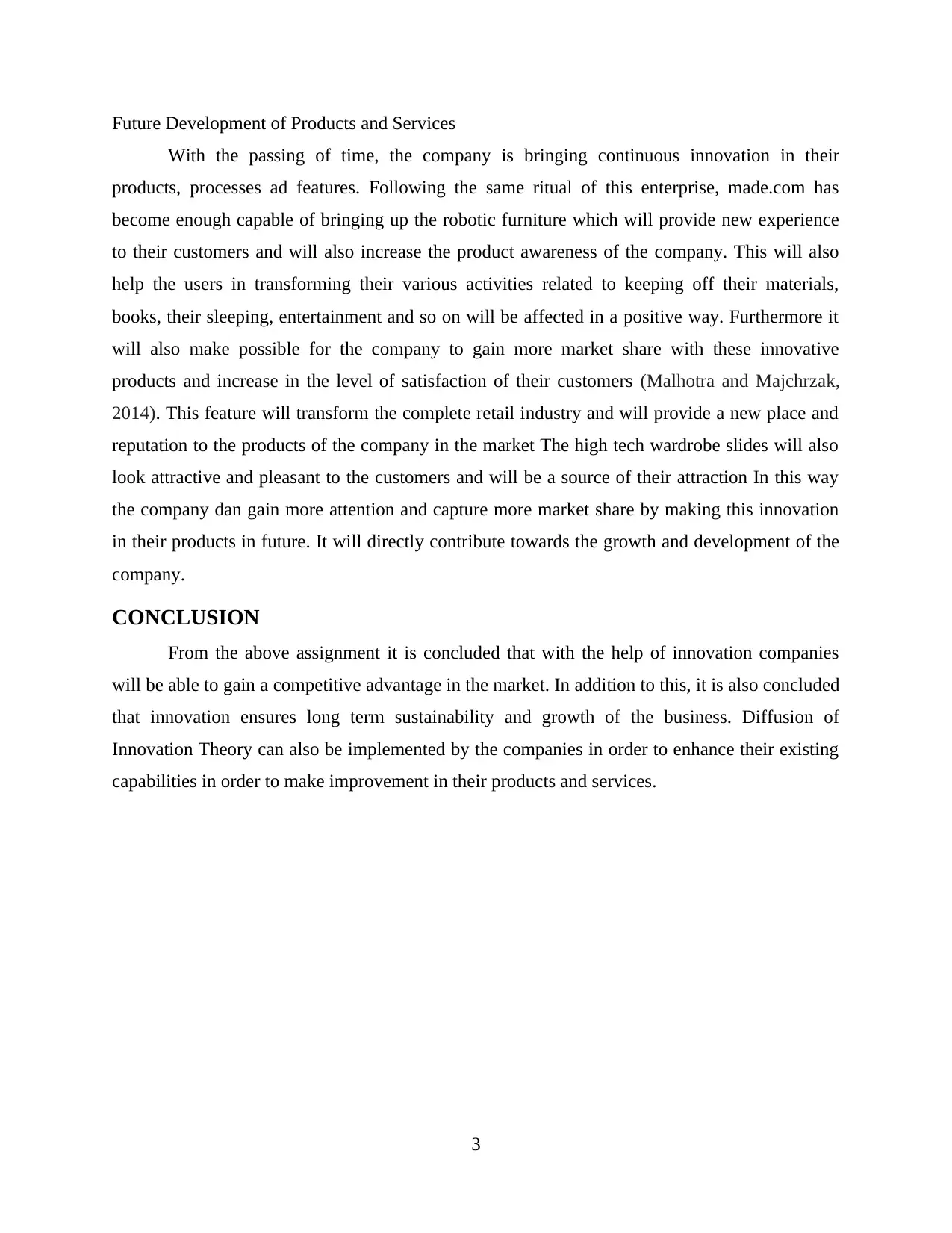
Future Development of Products and Services
With the passing of time, the company is bringing continuous innovation in their
products, processes ad features. Following the same ritual of this enterprise, made.com has
become enough capable of bringing up the robotic furniture which will provide new experience
to their customers and will also increase the product awareness of the company. This will also
help the users in transforming their various activities related to keeping off their materials,
books, their sleeping, entertainment and so on will be affected in a positive way. Furthermore it
will also make possible for the company to gain more market share with these innovative
products and increase in the level of satisfaction of their customers (Malhotra and Majchrzak,
2014). This feature will transform the complete retail industry and will provide a new place and
reputation to the products of the company in the market The high tech wardrobe slides will also
look attractive and pleasant to the customers and will be a source of their attraction In this way
the company dan gain more attention and capture more market share by making this innovation
in their products in future. It will directly contribute towards the growth and development of the
company.
CONCLUSION
From the above assignment it is concluded that with the help of innovation companies
will be able to gain a competitive advantage in the market. In addition to this, it is also concluded
that innovation ensures long term sustainability and growth of the business. Diffusion of
Innovation Theory can also be implemented by the companies in order to enhance their existing
capabilities in order to make improvement in their products and services.
3
With the passing of time, the company is bringing continuous innovation in their
products, processes ad features. Following the same ritual of this enterprise, made.com has
become enough capable of bringing up the robotic furniture which will provide new experience
to their customers and will also increase the product awareness of the company. This will also
help the users in transforming their various activities related to keeping off their materials,
books, their sleeping, entertainment and so on will be affected in a positive way. Furthermore it
will also make possible for the company to gain more market share with these innovative
products and increase in the level of satisfaction of their customers (Malhotra and Majchrzak,
2014). This feature will transform the complete retail industry and will provide a new place and
reputation to the products of the company in the market The high tech wardrobe slides will also
look attractive and pleasant to the customers and will be a source of their attraction In this way
the company dan gain more attention and capture more market share by making this innovation
in their products in future. It will directly contribute towards the growth and development of the
company.
CONCLUSION
From the above assignment it is concluded that with the help of innovation companies
will be able to gain a competitive advantage in the market. In addition to this, it is also concluded
that innovation ensures long term sustainability and growth of the business. Diffusion of
Innovation Theory can also be implemented by the companies in order to enhance their existing
capabilities in order to make improvement in their products and services.
3
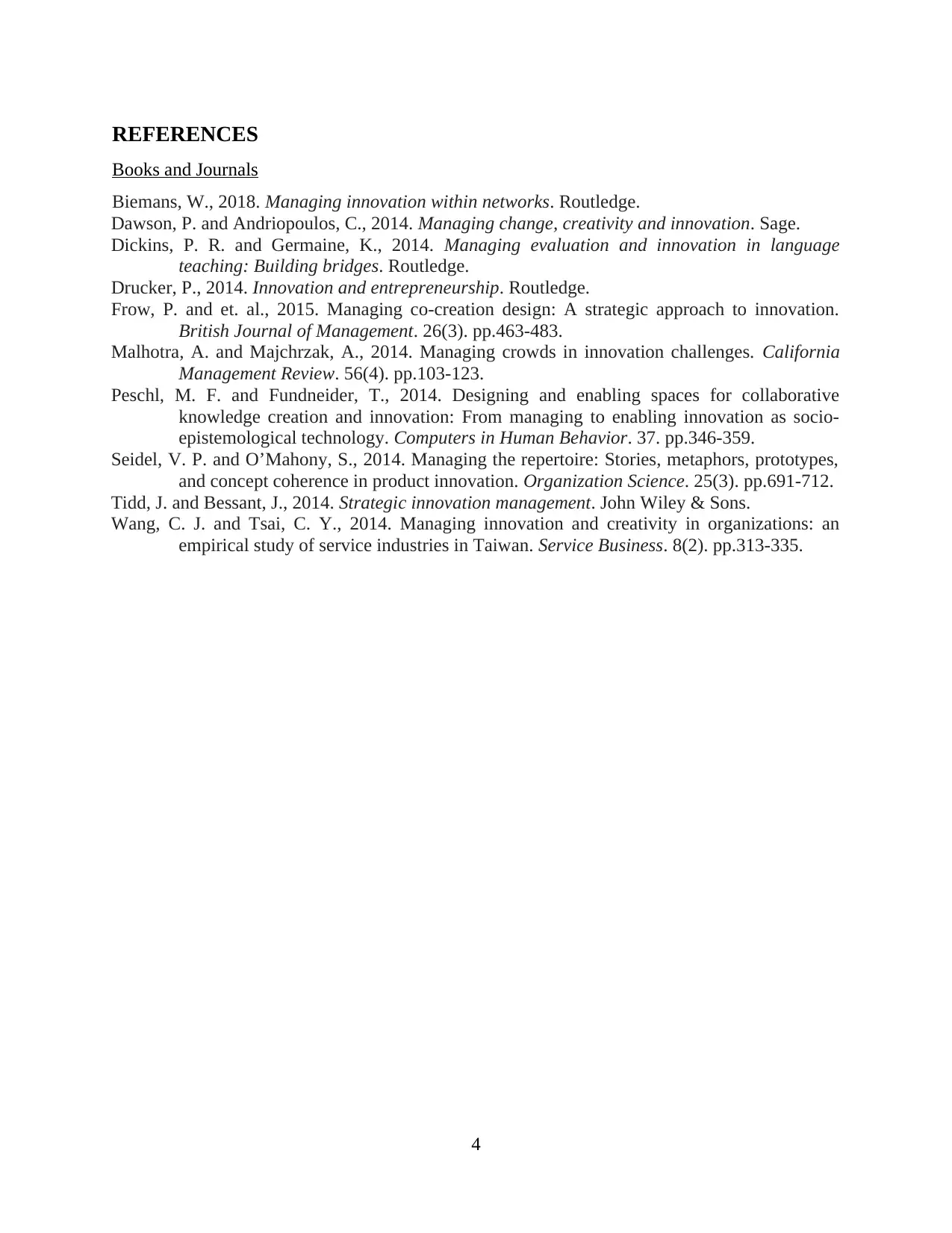
REFERENCES
Books and Journals
Biemans, W., 2018. Managing innovation within networks. Routledge.
Dawson, P. and Andriopoulos, C., 2014. Managing change, creativity and innovation. Sage.
Dickins, P. R. and Germaine, K., 2014. Managing evaluation and innovation in language
teaching: Building bridges. Routledge.
Drucker, P., 2014. Innovation and entrepreneurship. Routledge.
Frow, P. and et. al., 2015. Managing co‐creation design: A strategic approach to innovation.
British Journal of Management. 26(3). pp.463-483.
Malhotra, A. and Majchrzak, A., 2014. Managing crowds in innovation challenges. California
Management Review. 56(4). pp.103-123.
Peschl, M. F. and Fundneider, T., 2014. Designing and enabling spaces for collaborative
knowledge creation and innovation: From managing to enabling innovation as socio-
epistemological technology. Computers in Human Behavior. 37. pp.346-359.
Seidel, V. P. and O’Mahony, S., 2014. Managing the repertoire: Stories, metaphors, prototypes,
and concept coherence in product innovation. Organization Science. 25(3). pp.691-712.
Tidd, J. and Bessant, J., 2014. Strategic innovation management. John Wiley & Sons.
Wang, C. J. and Tsai, C. Y., 2014. Managing innovation and creativity in organizations: an
empirical study of service industries in Taiwan. Service Business. 8(2). pp.313-335.
4
Books and Journals
Biemans, W., 2018. Managing innovation within networks. Routledge.
Dawson, P. and Andriopoulos, C., 2014. Managing change, creativity and innovation. Sage.
Dickins, P. R. and Germaine, K., 2014. Managing evaluation and innovation in language
teaching: Building bridges. Routledge.
Drucker, P., 2014. Innovation and entrepreneurship. Routledge.
Frow, P. and et. al., 2015. Managing co‐creation design: A strategic approach to innovation.
British Journal of Management. 26(3). pp.463-483.
Malhotra, A. and Majchrzak, A., 2014. Managing crowds in innovation challenges. California
Management Review. 56(4). pp.103-123.
Peschl, M. F. and Fundneider, T., 2014. Designing and enabling spaces for collaborative
knowledge creation and innovation: From managing to enabling innovation as socio-
epistemological technology. Computers in Human Behavior. 37. pp.346-359.
Seidel, V. P. and O’Mahony, S., 2014. Managing the repertoire: Stories, metaphors, prototypes,
and concept coherence in product innovation. Organization Science. 25(3). pp.691-712.
Tidd, J. and Bessant, J., 2014. Strategic innovation management. John Wiley & Sons.
Wang, C. J. and Tsai, C. Y., 2014. Managing innovation and creativity in organizations: an
empirical study of service industries in Taiwan. Service Business. 8(2). pp.313-335.
4
⊘ This is a preview!⊘
Do you want full access?
Subscribe today to unlock all pages.

Trusted by 1+ million students worldwide
1 out of 6
Related Documents
Your All-in-One AI-Powered Toolkit for Academic Success.
+13062052269
info@desklib.com
Available 24*7 on WhatsApp / Email
![[object Object]](/_next/static/media/star-bottom.7253800d.svg)
Unlock your academic potential
Copyright © 2020–2025 A2Z Services. All Rights Reserved. Developed and managed by ZUCOL.





